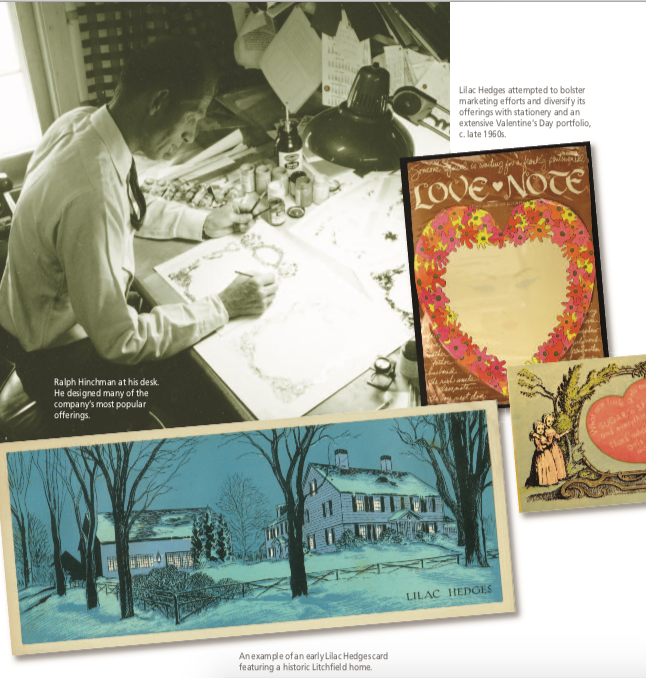By Linda Hocking
(c) Connecticut Explored Inc. Winter 2017-2018
Lilac Hedges was a greeting-card company in Litchfield, Connecticut in the 1950s and 1960s founded by Ralph P. Hinchman III (1921 – 2005). For the Litchfield Historical Society, the collection of cards and records donated by Hinchman’s sister, Elsa Hinchman Clark, and artists Jac Venza and Harry Dunn adds to an under-documented but significant era in Litchfield’s history. While Marcel Breuer was designing the town’s first modern house complete with art by Alexander Calder, Hinchman began what would become a national enterprise from his family’s property on Fern Road. Scant records, though, leave much of this story still to be documented.
Hinchman was born in Brooklyn, New York. After serving in World War II, he attended Cooper Union in New York and alternated his time between his grandmother’s and friends’ apartments in New York and his parents’ home in Litchfield.
In the early 20th century Hinchman’s grandparents purchased property that originally belonged to the historic Echo Farms—the first dairy to commercially bottle milk for distribution in New York City—and renamed it Lilac Hedges. After attending Cooper Union, Hinchman decided to try his hand at creating cards. His father provided financing (it’s unknown what his profession was), and Hinchman learned how to operate a business. The barn became Hinchman’s studio and provided a home—and a name—for the budding company. His first commercial order came in November 1950 from Cunard Steamships. They ordered 1,000 cards with an image of a steamship on the front.
Beginning with his own drawings of Litchfield houses, Hinchman created holiday cards to sell to friends in town. In order to expand, he needed to create a sample book from which customers could order. He decided to enlist artists he knew from New York, including Jac Venza, Hilary Knight (who would later achieve fame as the illustrator of the Eloise series of children’s books), Donn Sheets, Henry Bowman, and others—including a young Andy Warhol. Venza, became his co-creative director, a member of the company’s board, and took on the task of finding new artists.
They added a sales team. Major department stores such as Bergdorf Goodman and Bonwit Teller began carrying the line of cards. Needing to expand further, Hinchman invited Francis McIlhenney, a friend from Philadelphia, to be a business partner. McIlhenney focused on the daily operations of the business. The printer, Bill Exner, moved his press into the barn.
As the company grew, it had to diversify, for two reasons. First, having the bulk of income come during the Christmas holiday season made it difficult to operate year-round. Second, competition from Hallmark and other larger producers of greeting cards was fierce. It seemed that as soon as Lilac Hedges launched a new product, the larger companies were doing the same thing.
Hinchman’s designs were often inspired by historical research. He noted the popularity of a holiday design he made on a parchment-like paper and created other products with a similar historic feel. Soon after, he asked Hilary Knight to design invitations featuring a butler and a maid modeled after Helen Hokenson’s New Yorker cartoons of the 1930s and 1940s.
Although the company had expanded its line to include invitations, Valentines, blank note cards, and stationery, Hinchman struggled to make the business a financial success. In 1972 or 1973 he sold his share of the business to McIlhenney, who moved it to California where it may have only lasted a year or two.
After the sale of his business, Hinchman traveled throughout the south painting murals in private homes. He occasionally held art shows in the Lilac Hedges studio. He died in 2005.
Author’s Note: Thanks to Elsa Hinchman Clark for her donation of Lilac Hedges cards, drawings, and records, and artist Harry Dunn for his donation of cards he illustrated to Litchfield Historical Society, and Jac Venza, who provided much of the information in this article during an oral history interview in 2012.
Linda Hocking is curator of library and archives at the Litchfield Historical Society.

